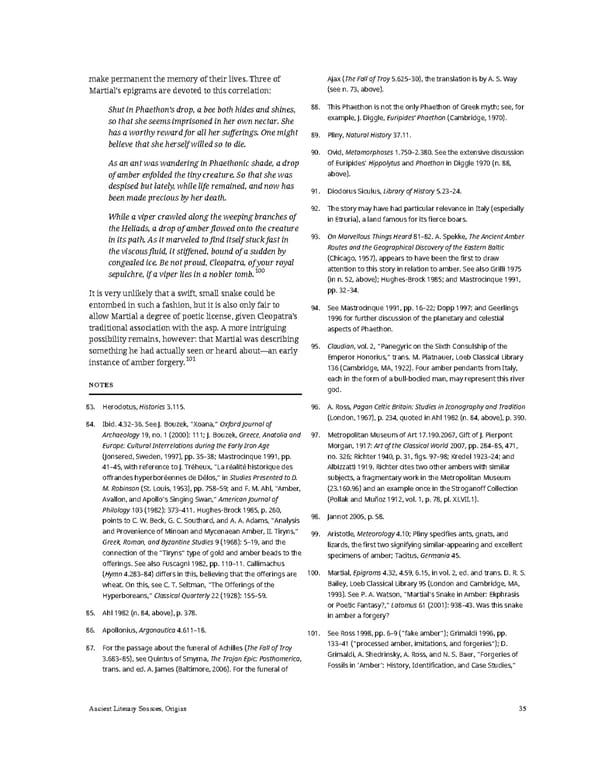make permanent the memory of their lives. Three of Ajax (The Fall of Troy 5.625–30), the translation is by A. S. Way Martial’s epigrams are devoted to this correlation: (see n. 73, above). Shut in Phaethon’s drop, a bee both hides and shines, 88. This Phaethon is not the only Phaethon of Greek myth; see, for so that she seems imprisoned in her own nectar. She example, J. Diggle, Euripides’ Phaethon (Cambridge, 1970). has a worthy reward for all her sufferings. One might 89. Pliny, Natural History 37.11. believe that she herself willed so to die. 90. Ovid, Metamorphoses 1.750–2.380. See the extensive discussion As an ant was wandering in Phaethonic shade, a drop of Euripides’ Hippolytus and Phaethon in Diggle 1970 (n. 88, of amber enfolded the tiny creature. So that she was above). despised but lately, while life remained, and now has 91. Diodorus Siculus, Library of History 5.23–24. been made precious by her death. 92. The story may have had particular relevance in Italy (especially While a viper crawled along the weeping branches of in Etruria), a land famous for its fierce boars. the Heliads, a drop of amber flowed onto the creature in its path. As it marveled to find itself stuck fast in 93. On Marvellous Things Heard 81–82. A. Spekke, The Ancient Amber the viscous fluid, it stiffened, bound of a sudden by Routes and the Geographical Discovery of the Eastern Baltic congealed ice. Be not proud, Cleopatra, of your royal (Chicago, 1957), appears to have been the first to draw sepulchre, if a viper lies in a nobler tomb.100 attention to this story in relation to amber. See also Grilli 1975 (in n. 52, above); Hughes-Brock 1985; and Mastrocinque 1991, It is very unlikely that a swift, small snake could be pp. 32–34. entombed in such a fashion, but it is also only fair to 94. SeeMastrocinque 1991, pp. 16–22; Dopp 1997; and Geerlings allow Martial a degree of poetic license, given Cleopatra’s 1996for further discussion of the planetary and celestial traditional association with the asp. A more intriguing aspects of Phaethon. possibility remains, however: that Martial was describing something he had actually seen or heard about—an early 95. Claudian, vol. 2, “Panegyric on the Sixth Consulship of the instance of amber forgery.101 Emperor Honorius,” trans. M. Platnauer, Loeb Classical Library 136 (Cambridge, MA, 1922). Four amber pendants from Italy, NOTES each in the form of a bull-bodied man, may represent this river god. 83. Herodotus, Histories 3.115. 96. A. Ross, Pagan Celtic Britain: Studies in Iconography and Tradition 84. Ibid. 4.32–36. See J. Bouzek, “Xoana,” Oxford Journal of (London, 1967), p. 234, quoted in Ahl 1982 (n. 84, above), p. 390. Archaeology 19, no. 1 (2000): 111; J. Bouzek, Greece, Anatolia and 97. Metropolitan Museum of Art 17.190.2067, Gift of J. Pierpont Europe: Cultural Interrelations during the Early Iron Age Morgan, 1917: Art of the Classical World 2007, pp. 284–85, 471, (Jonsered, Sweden, 1997), pp. 35–38; Mastrocinque 1991, pp. no. 326; Richter 1940, p. 31, figs. 97–98; Kredel 1923–24; and 41–45, with reference to J. Tréheux, “La réalité historique des Albizzatti 1919. Richter cites two other ambers with similar offrandes hyperboréennes de Délos,” in Studies Presented to D. subjects, a fragmentary work in the Metropolitan Museum M. Robinson (St. Louis, 1953), pp. 758–59; and F. M. Ahl, “Amber, (23.160.96) and an example once in the Stroganoff Collection Avallon, and Apollo’s Singing Swan,” American Journal of (Pollak and Muñoz 1912, vol. 1, p. 78, pl. XLVII.1). Philology 103 (1982): 373–411. Hughes-Brock 1985, p. 260, 98. Jannot 2005, p. 58. points to C. W. Beck, G. C. Southard, and A. A. Adams, “Analysis and Provenience of Minoan and Mycenaean Amber, II. Tiryns,” 99. Aristotle, Meteorology 4.10; Pliny specifies ants, gnats, and Greek, Roman, and Byzantine Studies 9 (1968): 5–19, and the lizards, the first two signifying similar-appearing and excellent connection of the “Tiryns” type of gold and amber beads to the specimens of amber; Tacitus, Germania 45. offerings. See also Fuscagni 1982, pp. 110–11. Callimachus (Hymn4.283–84) differs in this, believing that the offerings are 100. Martial, Epigrams 4.32, 4.59, 6.15, in vol. 2, ed. and trans. D. R. S. wheat. On this, see C. T. Seltman, “The Offerings of the Bailey, Loeb Classical Library 95 (London and Cambridge, MA, Hyperboreans,”Classical Quarterly 22 (1928): 155–59. 1993). See P. A. Watson, “Martial’s Snake in Amber: Ekphrasis or Poetic Fantasy?,” Latomus 61 (2001): 938–43. Was this snake 85. Ahl 1982 (n. 84, above), p. 378. in amber a forgery? 86. Apollonius, Argonautica 4.611–18. 101. SeeRoss 1998, pp. 6–9 (“fake amber”); Grimaldi 1996, pp. 87. For the passage about the funeral of Achilles (The Fall of Troy 133–41 (“processed amber, imitations, and forgeries”); D. 3.683–85), see Quintus of Smyrna, The Trojan Epic: Posthomerica, Grimaldi, A. Shedrinsky, A. Ross, and N. S. Baer, “Forgeries of trans. and ed. A. James (Baltimore, 2006). For the funeral of Fossils in ‘Amber’: History, Identification, and Case Studies,” Ancient Literary Sources, Origins 35
 Ancient Carved Ambers in the J. Paul Getty Museum Page 44 Page 46
Ancient Carved Ambers in the J. Paul Getty Museum Page 44 Page 46